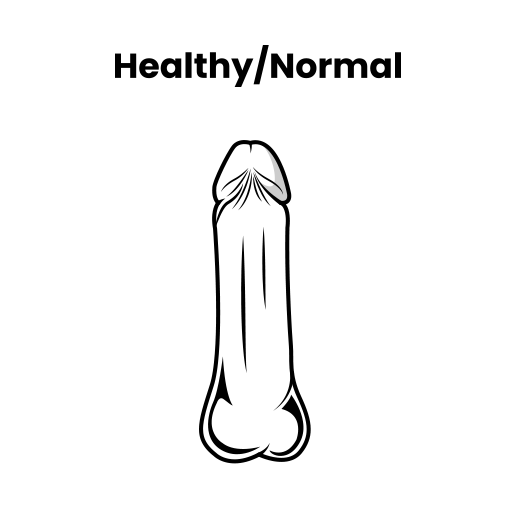Peyronie's should not be defined by it's many symptoms
Common Peyronie's Symptoms



What is a successful Peyronie's Disease treatment?
Many people, including lots of doctors would answer this question by saying: “reduce erect penile curvature”. But Peyronie's disease is not defined by a curve. In fact, over 30% of patients with a Peyronie's diagnosis have little or no curvature, but they still suffer from the build up of penile fibrosis and plaques in the soft tissue of the penis and the many negative side effects associated with that condition.
We believe the improved clinical definition for Peyronie's should be:
Peyronie’s Disease Redefined
Peyronie’s Disease (PD) is an acquired inflammatory condition characterized by the buildup of fibrous tissue plaques within the soft tissue of the penis and/or thickening of the tunica albuginea. In select cases, it’s triggered by a wound healing disorder.
Thus, a successful Peyronie's Disease treatment is one that measurably and permanently removes Peyronie's fibrous tissue plaques and reduces the size of an enlarged tunica (if applicable).
Thickening of the tunica albiquea is common with well- established Peyronies cases. Thickening can be defined both in terms of increased size from a form of swelling plus more pronounced tunica density.
Removal of Peyronie's fibrosis is complex since the size and nature of established plaques as well as existing patient health dynamics all play important roles with the exact protocol to permanently remove the penile fibrous tissue plaques.
At the onset, the plaques, fibrosis, and scar tissue that cause all Peyronie's symptoms can be precisely measured. Improvement can also be precisely quantified.
Uniquely compared to conditions like erectile dysfunction, the locations and sizes of Peyronie's fibrosis and penile plaques can be quantifiably measured, in mm3, by dynamic penile color Doppler sonography (readily available at most urology clinics) after administration of intracavernosal alprostadil 10 mcg. To calculate the volume of the penile plaque, plaques are measured in three dimensions and using an ellipsoid formula: V =_ _length × _width × _thickness × _0:52 which is typically used in the evaluation other urogenital diseases.
Thus, 99% of existing Peyronie's plaques, fibrosis and scar tissue can be fully quantified at the onset before any treatments begin and subsequently be reevaluated for signs of improvement through follow up sonography compared to the baseline to accurately determine if any therapeutic is eliminating Peyronie's plaque.
Because there has never been a unified standard for defining a successful Peyronie's treatment, existing Peyronie's treatment devices and drug treatment approved by the FDA refer to clinical trials that measured success by the degree of change in erect curvature, which is only a potential symptom of Peyronie's disease and proves nothing about healing the underlying cause of the curvature.
With all of this in mind, we believe it is critical to be as clear as we can about our use of statistics and to help clinicians and patients build appropriate expectations. Thus, we believe the revised gold standard for measuring improvement in regard to any Peyronie's treatment technology should include an initial duplex ultrasonography that both measures the size of any and all penile plaques and records their location within the soft tissue of the penis.
In our soon to be published clinical study of Peyronie's patients who completely treatment with ExoSurge IPG we saw a 79% reduction in fibrous tissue plaques (including cases with calcification) and a 60% reduction in measurable erect curvature (if applicable)

What causes Peyronie's Disease?
Have you ever searched “What causes Peyronie’s Disease?”
You'll quickly discover that "nobody knows for sure".
While the condition was named after François Gigot de la Peyronie, Louis XV's personal physician, in 1743, it was mentioned in medical journals much earlier in the Middle Ages. Thus, Peyronie’s has been recognized clinically for over 600 years, yet no one can fully explain its cause. There are theories, many debunked: since none are able to explain why a curve appears without warning or after any recallable penile injury in the vast majority of cases of otherwise perfectly healthy males.
How can you treat a disease if you don't know what's causing it? As Einstein so eloquently stated above, the emphasis should have been on the problem rather than on incidental solutions.
Where traditional Peyronie’s Care went wrong
Targeting the wrong problem
Why have so many attempts at a Peyronie’s solutions fallen flat? They targeted the wrong problem. They focused on treating the symptoms of the disease rather than the cause of the disease.
Every traditional Peyronie's care approach was invented using the concept that "problem-solving" equals invention. In other words, the penis becomes distorted from Peyronie's in size or shape while it is erect, which is the Peyronie's problem.
Thus, if I manually straighten my Peyronie's curvature through force with a traction device but the plaque that caused the curvature is still inside my penis, am I fixed? Am I good to go if my urologist injects a concentrated collagenase or enzymatic mixture into my penile plaque to soften the fibrosis enough to physically straighten my organ?
No, the underlying cause is still in place and the disease symptoms will resurface in the future.
What about the numerous instances (35% of cases ) of Peyronie's plaque and fibrosis in patients who exhibit little or no erect curvature? The majority of such patients we interviewed stated that they were questioned by clinicians about how "inconvenient" the problem was for them, even as their penile performance continued to decline.
Do these patients really not have Peyronie’s Disease?
Of course not.
The ExoSurge® pathway to the Peyronie’s cure
You cannot solve what you don’t understand.
The “problem” to be solved before anyone could invent a cure for Peyronie’s Disease is not within treating its many symptoms like erect curvature, lost length, shaft indentions when engorged, lost sensation and erectile dysfunction.
The root problem was this: “What causes Peyronie’s Disease?”
How could we develop a permanent solution to healing Peyronie’s disease if we didn’t understand its underlying etiology? We knew that wasn’t possible. We also felt this was the reason existing treatments came up short: they all provided solutions to treat various Peyronie’s symptoms, none focused on the removal of the basis for the disease itself.
During our twenty-year odyssey developing this breakthrough technology that permanently removes the fibrosis and penile plaques that triggers the symptoms that equate to a Peyronie’s diagnosis, we found it imperative to develop a “working theory” regarding the epidemiology of Peyronie’s Disease.
Those working theories were mailable early on but became static over the last seven years as our technology began to prove effectual.
Our working hypothesis regarding the etiology of Peyronie’s Disease is multi-faceted and includes case and patient specific variables. We understand it will require numerous future studies to achieve optimal clinical accuracy.
However, we’ve reached a point using our working theory method in tandem with our treatment devices and protocols where, all,
- meaning 100% of Peyronie’s patients,
- meaning patients with heavily calcified plaque,
- meaning diabetic patients,
- meaning patients with ventral plaque,
- meaning patients with hourglass shaping,
- meaning patients with curvature starting at the base -
- all patients who complete treatment with our technology see a permanent reduction in penile fibrosis and plaques.
We got it right.
Stay Up To Date
If you are a Peyronie's patient who has interest in participating in one of our upcoming clinical trials around the United States, please click here
If you are a urologic clinician who has a potential interest with being involved in our upcoming prospective clinical trials, please click here
If you would like to stay abreast of our progress during clinical trials and in the future, please click here:
Sign up to follow our story and to watch us grow!